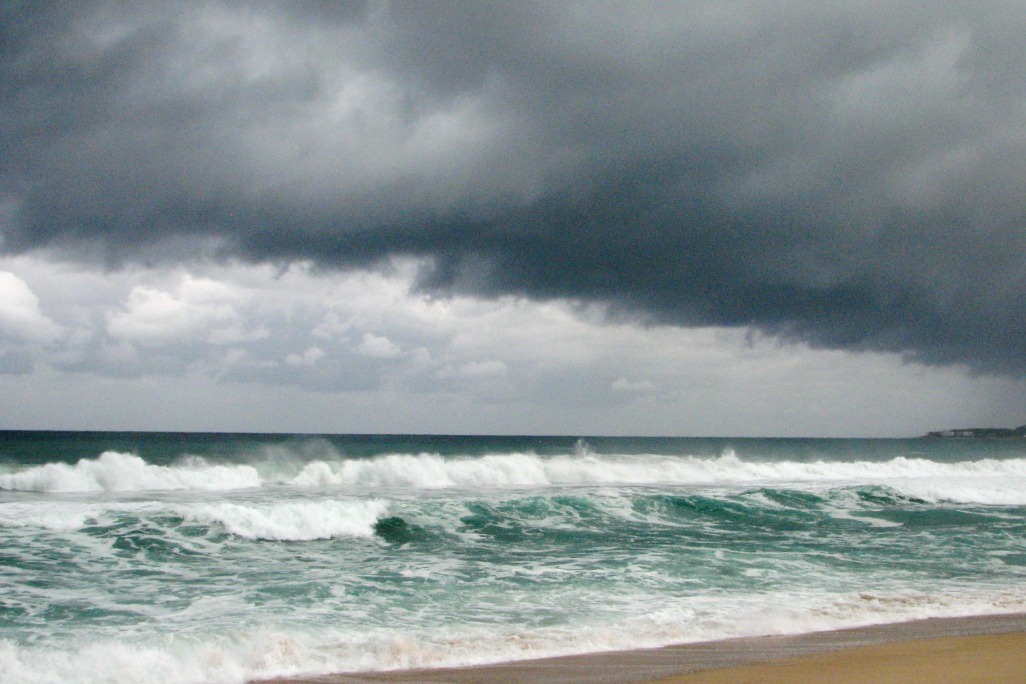Trigger warning?
中国日报网 2017-12-22 11:24

 Reader question:
Reader question:
Please explain the term “trigger warning”.
My comments:
Content warning, in other words.
“Trigger warning” is a relatively new term, an Internet-era coinage, something largely unheard of 20 years ago.
Anyways, today, at the beginning of a story online, we often see a content warning, such as this:
Warning: This interview contains strong language (i.e. curse words which may be unsuitable for children).
Or this:
Warning: This video may contain violence and graphics that are not suitable for people with heart conditions.
In the second case, that content warning is a trigger warning.
Trigger?
Trigger, as in “pull the trigger” to fire a gunshot.
Literally, trigger warning is a warning against certain language or image that may trigger some reaction in the viewer, usually something unpleasant.
For example, people with heart conditions may not be suitable to watch a film of extreme violence, which may give them a heart attack. Hence, a warning before hand is helpful and may do a great deal of good. They may choose to stop or at least they are alerted and may get mentally prepared if they choose to go on watching.
Or someone who has a traumatic childhood may find it difficult to watch a film or view a picture of children being beaten by adults. It may cause them incontrollable pain.
Or, for another example, a guilty war veteran may not want to watch a war film that features a lot of senseless killings. Such a film may trigger remembrances of their own experiences in combat.
In all of the above cases, a content warning about possible offensive or upsetting material is called a trigger warning, because it may trigger (cause) viewer discomfort.
Discomfort is putting it mildly, of course. It may be much worse.
Alright?
All right. No more ado, let’s read a few media examples to help us see “trigger warning” or “trigger warnings” in action and understand them better – via context:
1. Under the guise of trying to protect students from speech that they may find uncomfortable or offensive, there is a growing trend of rules and policies being put into place on college campuses that stifle debate, conversation, and learning.
For example, some college professors now provide “trigger warnings,” which aim to alert students about course content that they may find traumatic. Some colleges offer “safe spaces,” where students can go if they are troubled by a particular intellectual debate or conversation that is occurring on campus. And some colleges preemptively shut down free discussion by withdrawing commencement speaking invitations from prominent figures after upset students protest those figures for having different views.
What these efforts have in common is that they allow students to avoid reading or hearing ideas they find troubling. The systematic silencing that is occurring on campus teaches the next generation of leaders that the best way to deal with ideas with which they disagree is to declare the content offensive, disengage from the discussion, ignore the ideas, and force others to do the same by shutting down the conversation.
But a growing number of people are now questioning whether college students really benefit when they are taught to avoid contentious debates like ostriches burying their heads in the sand.
Credit none other than President Barack Obama, himself a former professor, for warning about the problem of the stifling of intellectual diversity on college campuses and the coddling of liberal college students.
At an appearance in Iowa, the President criticized the trend of campuses denying conservative speakers the opportunity to be heard and acknowledged the value of engaging with different viewpoints. “[A]nybody who comes to speak to you and you disagree with, you should have an argument with them,” Obama urged. He continued, “But you shouldn’t silence them by saying, you can’t come because I’m too sensitive to hear what you have to say. That’s not the way we learn, either.”
He is right. Protecting students from ideas that they may disagree with ultimately is a disservice to the students themselves, denying them the opportunity to consider, confront, and learn from differing opinions.
- Trigger Warning: Obama Criticizes The Language Police On College Campuses, Forbes.com, October 30, 2015.
2. As educators and students suited up for the fall semester last month, University of Chicago dean of students John Ellison sent a provocative letter to incoming freshmen about all the cushioning policies they should not expect at their new school. “We do not support so-called ‘trigger warnings,’ we do not cancel invited speakers because their topics might prove controversial, and we do not condone the creation of intellectual ‘safe spaces’ where individuals can retreat from ideas and perspectives at odds with their own,” Ellison wrote.
Ellison’s pre-emptive strike against trigger warnings, or alerts that professors might stamp on coursework that could provoke a strong emotional response, was the latest salvo in a yearslong and stormy conversation on college campuses—a kind of agon between “free speech” and “safe spaces.” The University of Chicago missive seemed to plant a flag in the former camp, declaring itself a Political Correctness Avenger, its cape of First Amendment verities fluttering in the wind.
Its side of the debate insists that students have embraced an ethos of personal fragility—that they are infantilizing themselves by overreacting to tiny slights. A splashy Atlantic cover story from September 2015 on the “coddling of the American mind” argued that universities were playacting at PTSD, co-opting the disorder’s hypersensitivity and hypervigilance. The other side protests administrators’ lack of awareness of marginalized groups; these students say they seek more inclusive, responsive, and enlightened spaces for learning. For them, the “tiny slights” have a name—microaggressions—and a high cost. They accumulate like a swarm of poisonous bee stings. As one outgoing college senior at American University told the Washington Post in May, “I don’t think it’s outrageous for me to want my campus to be better than the world around it. … I think that makes me a good person.”
The Atlantic piece cited Chinua Achebe’s Things Fall Apart and F. Scott Fitzgerald’s The Great Gatsby as two classic texts that have stirred calls for trigger warnings due to their racially motivated violence and domestic abuse, respectively. Students at Rutgers in 2014 beseeched a professor to append a trigger warning to descriptions of suicidal thinking in Mrs. Dalloway; students at Columbia did the same in 2015 for scenes of sexual assault in Ovid’s Metamorphoses. In some cases, the flags are meant to shepherd students away from high-voltage material; in others, they simply advise readers to be prepared. Often derided or ironized online by concerned citizens (and especially by free speech advocates), they are a response to something real: Scientists agree that triggers can awaken dormant memories and hijack the rational control board of the cortex, drowning awareness of the present moment in eddies of panic.
As Ali Vingiano recounts for BuzzFeed, trigger warnings were born not in the ivory tower but on the lady-blogosphere, where they prefaced message-board postings about topics like self-harm, eating disorders, and sexual assault. The advisory labels swam to LiveJournal in the early aughts, then spread across Tumblr, Twitter, and Facebook. By 2012, they speckled such feminist sites as Bitch, Shakesville, and xoJane, creating protective force fields around articles that touched on everything from depression to aggressive dogs. These internet “heads up” notes allowed vulnerable readers to tread lightly through and around subjects that reignited their pain. But they also acquired a sanctimonious, performative aura. “As practiced in the real world,” Amanda Marcotte wrote in Slate last year, “the trigger warning is less about preventive mental health care and more about social signaling of liberal credentials.”
Similarly, the vaudeville toughness of Ellison’s letter felt designed more to make a cultural point than to edify students. Enacted correctly, the measures Ellison invokes are not supposed to constrict academic horizons. They are meant to secure for minority students the same freedoms to speak and explore that white male students have enjoyed for decades.
- The Trapdoor of Trigger Words, Slate.com, September 5, 2016.
3. NPR Ed sent out a survey last fall to faculty members at colleges and universities around the country. We focused specifically on the types of institutions most students attend — not the elite private universities most often linked to the “trigger warning” idea.
We received more than 800 responses, and this month as the issue once again made headlines we followed up with some of those professors.
Here are some of our key findings:
About half of professors said they've used a trigger warning in advance of introducing potentially difficult material.
Most said they did so of their own volition, not because of a student’s request or an administrative policy.
...
Let’s define terms.
The term “trigger” in this sense originates in psychology, where it pertains to people with a diagnosis of post-traumatic stress disorder. For survivors of combat violence, sexual abuse or other trauma, certain sights, sounds, smells or other reminders can bring on intense emotional and even physical reactions, like a full-blown panic attack.
In the media and elsewhere online, language similar to trigger warnings is often used more broadly to label material that concerns sexual abuse or sexual assault, that is potentially racially or politically offensive, or graphically violent or sexual. For example, when NPR covered the fatal shooting by police of Philando Castile, an African-American resident of the Minneapolis area, we included these words: “We’ll embed the video here, with the warning that it contains images and language that viewers might find disturbing.”
But the rules are different in a college classroom than in a therapeutic setting, and both are different than when addressing a general audience. Even some of our respondents who had supplied a form of trigger warning as a “courtesy” or “heads-up” said they didn’t intend to give students a free pass to avoid uncomfortable topics.
In fact, the picture that emerges is of professors making private decisions within the four walls of the classroom. Only 3.4 percent said students had requested such a warning. Most instructors who told us they'd used trigger warnings — 64.7 percent — did so because, they said, “I thought the material needed one.”
So what are the types of material that are most likely to trigger a trigger warning?
Our respondents were most likely to say they had used trigger warnings in reference to sexual or violent material. Racially, politically, or religiously charged topics were mentioned less often.
“I have had students break down reading novels depicting sexual assault and incest in my gender studies courses,” a professor at the University of North Carolina said in a survey response.
Joanna Hunter, who teaches sociology at Radford University in Virginia, told NPR Ed last week that she has given a warning before explaining the practice of female genital mutilation, within the broader context of a discussion of cultural relativism.
Lauren Griffith, a professor of ethnology at Texas Tech University, said that she gave warnings when teaching Native American students whose religious beliefs required that they undergo a form of ritual purification upon viewing images of death. However, she says, outside of such specific situations, she doesn't believe that trigger warnings best serve the cause of liberal education: “I think that trigger warnings can and should be used in a limited number of situations, but overusing them can create a situation in which students opt out of learning experiences simply because they don’t want to confront their own assumptions about the world.”
- Half Of Professors In NPR Ed Survey Have Used ‘Trigger Warnings’, NPR.org, September 7, 2016.
本文仅代表作者本人观点,与本网立场无关。欢迎大家讨论学术问题,尊重他人,禁止人身攻击和发布一切违反国家现行法律法规的内容。
About the author:
Zhang Xin is Trainer at chinadaily.com.cn. He has been with China Daily since 1988, when he graduated from Beijing Foreign Studies University. Write him at: zhangxin@chinadaily.com.cn, or raise a question for potential use in a future column.
(作者:张欣 编辑:丹妮)

















 英语点津微信
英语点津微信 双语小程序
双语小程序